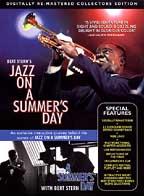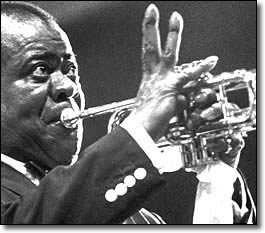FILM NOTES
FILM NOTES INDEX
NYS WRITERS INSTITUTE
HOME PAGE

 Jazz on a Summer's Day
Jazz on a Summer's Day
(United States, 1960, 85 minutes, color, 35mm)
Directed by Aram Avakian and Bert Stern
Starring: Anita O'Day, Thelonious Monk, George Shearing, Gerry Mulligan
Louis Armstrong, Dinah Washington, Mahalia Jackson, Chuck Berry
The
following film notes were prepared for the New York State Writers
Institute by Kevin Jack Hagopian, Senior Lecturer in Media Studies
at Pennsylvania State University:
Young Bert Stern was already one of the leading fashion photographers of the 1950's when he resolved to shoot his first film before he was thirty. He made it, with two years to spare. The result, Jazz on a Summer's Day, is a luminously breezy film that brings the rich color palette of Vogue or Harper's Bazaar of those years into the world of the documentary cinema. Along with Monterey Pop, and Woodstock, and The Last Waltz, Bert Stern and his co-director, the equally well-regarded jazz connoisseur Aram Avakian, created one of the great concert films, but Jazz on a Summer's Day is more than that: it is a meandering summer stream of a film, always ready to glance away from the music for a minute, to take in a girl in a red sweater, or a fat guy in his swimming trunks, or kids playing, always ready to let the incredible music it captures take the film into new flights of improvisation and imagination.
But, oh, that music. Jazz on a Summer's Day captures the 1958 Newport Jazz Festival, a summit meeting of jazz greats we'll never see the like of again. The Festival had been started in 1954 on the greenswards of Newport, Rhode Island, the brainchild of a young impresario and jazz lover named George Wein. It seemed a strange match, as the seaside home of American old money became, for a few days every summer, the home of a music that had grown from anonymous, working class roots. But soon Newport rang to the brilliant sounds of the jazz aristocracy. The Duke Ellington orchestra's performance on the night of July 8, 1956, of "Diminuendo and Crescendo in Blue," with solo saxophonist Paul Gonsalves taking an incredible 27 straight choruses, typified the electricity that Newport generated. By the late 1950's, the festival quickly became the gathering place for the greatest musicians, and their adoring fans came in the thousands. Newport sired dozens of jazz festivals that to this day circulate the jazz gospel to the faithful, and to a new generation of fans, all summer long in cities and towns across the country.
 Wein had wanted to document the festival for years, but despaired of ever getting releases from all the acts, who were under contract to a dozen or more record labels and who knows how many managers. It was Stern who said, "Why don't I just shoot it, and I'll get the releases later?" Stern reasoned, with the brashness of youth, that if he made a great film, the artists would gladly allow their images to be used. He was right. As a fashion photographer, Stern was used to meticulously lighting his subjects. Fine, but it's a lot easier to light a professional haute couture model in a studio than the entire playing field of a Rhode Island high school, which was the setting for the 1958 festival. At his own expense, Stern trucked in lights, and shot the film on the richest, most saturated of color stocks. Stern said that he wanted to bring jazz out of the cellars and into the sunlight, and he succeeded. Stern's biggest cinematic influence, he said, were not so much other documentaries as the great English cinematic colorist Michael Powell, whose The Red Shoes had made an indelible impression on a teenaged Stern. The result is that Jazz on a Summer's Day has more in common with, say the previous years Richard Avedon-Stanley Donen collaboration, Funny Face, than with most documentaries of the period. Stern's Kodachrome aesthetic makes Jazz on a Summer's Day a harbinger of the expressive color documentaries of recent times such as Winged Migration and March of the Penguins. Stern was a major contributor to a small but vital tradition of abstract documentary portrayals of jazz, beginning at least with Life magazine photographer Gjon Mili's lyrical 1945 short film, "Jammin' the Blues," and extending to fellow fashion photographer Bruce Weber's moody 1989 film about trumpet player Chet Baker, Let's Get Lost.
Wein had wanted to document the festival for years, but despaired of ever getting releases from all the acts, who were under contract to a dozen or more record labels and who knows how many managers. It was Stern who said, "Why don't I just shoot it, and I'll get the releases later?" Stern reasoned, with the brashness of youth, that if he made a great film, the artists would gladly allow their images to be used. He was right. As a fashion photographer, Stern was used to meticulously lighting his subjects. Fine, but it's a lot easier to light a professional haute couture model in a studio than the entire playing field of a Rhode Island high school, which was the setting for the 1958 festival. At his own expense, Stern trucked in lights, and shot the film on the richest, most saturated of color stocks. Stern said that he wanted to bring jazz out of the cellars and into the sunlight, and he succeeded. Stern's biggest cinematic influence, he said, were not so much other documentaries as the great English cinematic colorist Michael Powell, whose The Red Shoes had made an indelible impression on a teenaged Stern. The result is that Jazz on a Summer's Day has more in common with, say the previous years Richard Avedon-Stanley Donen collaboration, Funny Face, than with most documentaries of the period. Stern's Kodachrome aesthetic makes Jazz on a Summer's Day a harbinger of the expressive color documentaries of recent times such as Winged Migration and March of the Penguins. Stern was a major contributor to a small but vital tradition of abstract documentary portrayals of jazz, beginning at least with Life magazine photographer Gjon Mili's lyrical 1945 short film, "Jammin' the Blues," and extending to fellow fashion photographer Bruce Weber's moody 1989 film about trumpet player Chet Baker, Let's Get Lost.
But the music was the reason for Newport, and for this film. Stern memorialized some of the finest jazz artists of midcentury. Stern concentrated his energies on photographing a single day of the four day festival, but because of Wein's extraordinary programming, that meant that Stern's cameras captured Louis Armstrong, Gerry Mulligan, Buck Clayton, Thelonious Monk, Jack Teagarden, Dinah Washington, Sonny Stitt, Jo Jones, Chico Hamilton, Jim Hall, Jimmy Giuffre, Bob Brookmeyer, Terry Gibbs, Urbie Green, Max Roach, Art Farmer, George Shearing, Eric Dolphy, all on one musically miraculous Saturday... If there's a star of Jazz on a Summer's Day, it is surely the exquisite Anita O'Day, dressed like one of Stern's Vogue models in white gloves and an outrageously elegant hat in the single recorded performance which came to measure her entire career. Anita's swingin' renditions of "Sweet Georgia Brown" and "Tea for Two" perfectly capture the insouciant, almost weightless feel Stern aimed for. Wein was also an eclectic programmer, so you'll also see Mahalia Jackson in a passionate take on "Didn't It Rain?", and even Chuck Berry is in attendance.
Jazz on a Summer's Day has been called a "snapshot of a day in Eisenhower's America," though that designation suggests artlessness; another critic compared the film to Robert Frank's Americans, an influential photographic suite of life in the USA in the 1950's. The America's Cup trials happened to be going on off Newport on that summer Saturday in 1958, and Stern's camera watches the audiences watching the boats, as well as watching the music. Stern's glimpses of the crowd creates momentary but unforgettable characters in the passing scene. His soft-spoken, observational camera and plein-air shooting style give the film a lightness of being that is the perfect visual correlative of the cool jazz greats of the day, like Mulligan. This is Degas at the races, in 4/4 time.
If Jazz on a Summer's Day doesn't look like a "typical documentary," that's because there is no such thing, thanks in part to films like this. (The grandfather of documentary cinema, John Grierson, loved Jazz on a Summer's Day, and in the early 1960's used to excerpt it regularly on his BBC program devoted to the documentary art in the 1960's.) One of Newport's real aristocrats, Duke Ellington, used to say that his music was "beyond category." So it is with Jazz on a Summer's Day, a film as warm as a summer's day, as light as a smile.
— Kevin Hagopian, Penn State University
For additional information, contact the Writers Institute at 518-442-5620 or online at https://www.albany.edu/writers-inst.